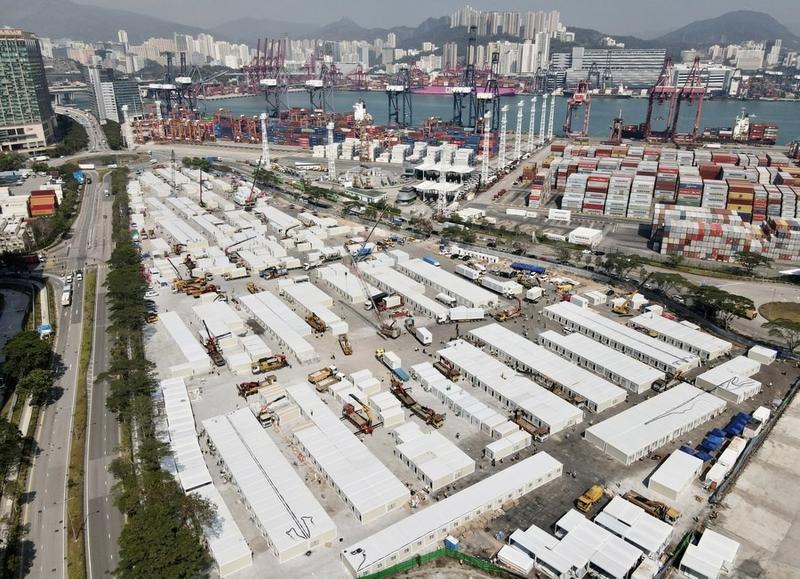 This aerial photo shows people working at the construction site of Tsing Yi mobile cabin hospital in Hong Kong, on Feb 26, 2022. (PHOTO / XINHUA)
This aerial photo shows people working at the construction site of Tsing Yi mobile cabin hospital in Hong Kong, on Feb 26, 2022. (PHOTO / XINHUA)
Hong Kong Chief Executive Carrie Lam Cheng Yuet-ngor said her government has identified nine sites to build community isolation facilities with the help of the central government.
The facilities will be able to provide over 50,000 units for quarantine purposes, she told a daily COVID-19 news conference on Thursday.
Apart from the identified new land sites, we will utilize our existing resources such as Lei Yue Mun Park Resort, completed public real estate units that are not yet occupied, and hotel rooms provided by designated quarantine hotels to increase the number of community isolation facilities.
Carrie Lam Cheng Yuet-ngor, Hong Kong Chief Executive
Lam said the Hong Kong Special Administrative Region government will adopt triage treatment procedures and enhance the number of isolation facilities to contain the pandemic.
READ MORE: 6 isolation facilities in HK to be put into use within March
"Apart from the identified new land sites, we will utilize our existing resources such as Lei Yue Mun Park Resort, completed public real estate units that are not yet occupied, and hotel rooms provided by designated quarantine hotels to increase the number of community isolation facilities," she said. "We estimate there may be up to 70,000 community isolation units or beds in Hong Kong."
Lam said the average stay in an isolation unit is five days. She appealed to Hong Kong residents to stay at the isolation facilities if required to reduce the risk of the pandemic spreading further in the community.
She told Xinhua News Agency that the SAR government has taken account of suggestions by mainland experts who called for anti-pandemic efforts to focus on minimizing infections, severe cases and deaths.
Lam said the concentration of medical resources is important because the limited resources should be channeled to areas of greatest need in order to ensure Hong Kong people, especially the elderly, are well protected from COVID-19.
Erik Yim Kong, a member of the Hong Kong Legislative Council, said he agreed with the points Lam made in the interview with Xinhua.
"The SAR government should mobilize all the bureaus and public servants in the virus battle," he said, adding that it also needs to make sure medical resources from the mainland are transferred to Hong Kong promptly and better utilized in fighting the pandemic.
Yim also suggested the government could pay more attention to promoting the application of telehealth technology such as video diagnosis in the anti-pandemic fight, which could alleviate the city's shortage of medical resources.
Shiu Ka-fai, another Legislative Council member, expressed his support for the strategy of prioritizing the treatment of the elderly and children, and said medical resources should be deployed to treat those cases with severe symptoms.
"When the isolation facilities are ready, these facilities should be better coordinated to complement the proposed compulsory COVID-19 testing so as to prevent community outbreaks," he said.
Liang Wannian, head of the National Health Commission's COVID-19 leading task force, said the novel coronavirus situation in Hong Kong is reaching a plateau, with the exponential rise in cases suppressed and case numbers staying at around 40,000 to 50,000 a day for the past few days.
Liang said he believes the SAR government will take a series of factors into consideration when planning a universal COVID-19 testing exercise, including the purpose of testing, its feasibility, and an appropriate allocation of resources, before deciding when to proceed.
ALSO READ: Mainland expert: Exponential rise of virus cases in HK stopped
According to government figures released on Thursday, Hong Kong logged 31,402 new COVID-19 cases, including 7,012 through the new online portal for positive rapid antigen test results.
It has seen more than 600,000 cases since the fifth wave of the pandemic in the city started in late December.
Ao Yulu contributed to this story.


